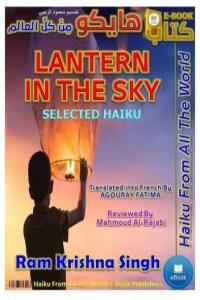Creation and Criticism
ISSN: 2455-9687
(A Quarterly International Peer-reviewed Refereed e-Journal
Devoted to English Language and Literature)
Vol. 07, Joint Issue 24 & 25: Jan-April 2022

Critique
Lantern in the Sky: Spirit behind the Words
Pravat Kumar Padhy
Prof. Ram Krishna Singh is a celebrated modern Indian English mainstream poet and has the credit of being one of the finest haiku and tanka poets during the formative stage of development of the Japanese short forms of poetry in India. R K Singh has contributed a lot to popularize haiku-like short poems in India during the early seventies. Describing the essence of haiku, he suggests, “It is the spirit behind the words that counts: the pauses, hesitations, and the silences between words and between the lines, the silences that make a poem live and breathe. That is what makes a good haiku.”
In the present collection, Lantern in the Sky, titled from one of the haiku poems, the mélange of imageries of the personal experience, the human psyche, the celestial references, and the sense of gratification of divinity have been artfully portrayed. The collection includes the translation of haiku in French by Agouray Fatima.
“You are different by just being yourself. Close your mind. Close your eyes. See with your heart to feel what others can only see,” as Mahmoud Al-Rajabi aptly summarizes the essence of haiku in the Preface to the collection. The poet tries to image various spectrums related to nature entwined with emotion, love, grief, and zen-feeling with spiritual pursuits. The collection reveals references to vivid visual observations, from the sky to the hill, and the spider to the bees. He tries to render his observations into art-of-words, leaving enough space for the readers to unveil. It reminds us of what Wordsworth calls “spot of time”, as the spontaneous reflection is seen in R K Singh’s haiku poems. At places, he is influenced by the philosophical aspects of Zen Buddhism.
Prof. Singh, with sharp craftsmanship, uses the haiku elements such as depth and mystery (yugen), contained space(ma), pathos (aware), becomingness (kokora), lightness(karumi), creativeness(zoko), elegance (fuga), and simplicity(iki) in a very thoughtful style. It is a delight to read the poems along with the splendid paintings of emitting the light of lantern up into the sky, as if depicting energy and brightness associated with womanhood.
The poet deals with socio-economic issues with unequivocal imageries of searching for food by the dog and girl together! His poetic sincerity is reflected in correlating ‘frail back’ of the woman and ‘autumn evening’:
searching for food
in the street garbage
a dog and girl
***
a load of wood
on her frail back –
autumn evening
He focuses his observation on a poor woman struggling to catch fish in exchange for some coins to buy milk for the new-born. In the following haiku, line 3 takes a different swing at the end to a deeper meaning. Here the ‘knee-deep’ can be correlated with the drying pond juxtaposing perhaps her lean health.
knee-deep in the pond
awaits fresh catch to buy milk
for the new-born
It reminds me of Tony Pupello’s essay ‘Voices: Poverty in Haiku’ citing Richard Wright’s haiku, “I am paying rent/ For the lice in my cold room/ And the moonlight too.” Tony Pupelo writes, “Abject poverty, in my view is, precisely, a lack of choice. In a state of abject poverty there is no choice; there are no options. Without options, one finds oneself (or a family finds itself), trapped, a victim to whatever winds are blowing.”
R K Singh manifests the subtle expression of gracefulness and poetic sensitivity in the following haiku:
her fingers
I taste in the orange
she peels
There has been a close parallel in the aesthetic sense what Basho inks:
The butterfly is perfuming
Its wings, in the scent
Of the orchid. (Nishio, 379-80)
Poetry with honesty, depth, and mystery (yugen) has been beautifully crafted by R K Singh. In the following haiku he is awakened by the light of mystery and imagination of darkness. The use of whites pace (ma), the dimension beyond the images, is meditatively displayed in the following haiku:
watching
the darkness between the stars
enlightenment
The contrast juxtaposition between the light of enlightenment and darkness between stars is a brilliant creation. Let us compare how splendidly Bruce H. Feingold composes his monoku with insight: "letting out/ my breath/ a billion stars."
And visit the mystic expression by Rabindranath Tagore in one of his epigrammatic expressions:
The stars of night are to me
the memorials of my day's faded flowers.
The ethical self-realization (zen feeling) symbolizes the essence of spiritualism. Rightly Blyth says, “haiku is a form of Zen”. R K Singh writes poems embedded with a sense of ecstasy. According to the Pali canon, Harold Stewart opines, haiku as related to meditation, and says,“the longest process of consciousness caused by sense perception consists of seventeen thought-instants (cittakkhana) each briefer than a lightning flash”.
This evokes ethical goodness with a meditative tone and searching for the light of peace journeying through the infinite sky. Gracefully Singh pens:
on the river bank
his soul is lighted for peace—
lantern in the sky
His poems are often characterized by a sense of solitude (sabi) as he says, “awake/ alone on the house top/ a sparrow.” He discovers the language of silence in a different orbit. I think it is not to exaggerate to say about him, quoting Subramania Bharathi’s excerpt from the article on “Japanea Kavidhai” (Japanese poetry)” in Swadesamitran in its 16th October 1916 issue based on a haiku article written by Yonae Noeguchi in Modern Review, Calcutta: “The one who understands loneliness and silence and the language of the flowers and lives in oneness with nature is a poet.” The poet deeply discovers the inner sense as he unfolds:
in silence
one with divine will
growing within
Let us compare the elegance of ‘silence’ in the manifestation of the celestial body (sun) by haiku Master, Buson, with that of (moon) by R K Singh in the following haiku:
mist on the grass
on soundless waters
the sunset
The activity-driven poetic enchantment within the realm of silence (white space) has been wonderfully pictured by the poet:
drifting
in the night’s silence
moon’s shadow
Metaphorically he articulates the serenity when he opines purity has no shadow. It’s a brilliant search by the poet!
the sky
without a shadow
on the earth
The poet portrays the psychological tension of a man through complex imageries of unexpectedness (atarashimi) and drifting mood (nioi). One can closely observe the art of ‘leap’in the last line of the haiku:
prayer book
covering the glass—
his last drink
Jeffrey Winke pens, “Eroticism and haiku are a perfect fit. Just as the haiku is the art of indirection, so too erotica. Whereas the explicit is an imaginative endpoint, the best haiku are a suggestive starting point for the imagination.” Prof. Singh has pioneered in presenting romanticism with sensual touch in his mainstream poetry. Some of his haiku are entwined with sensual imageries depicting the human psyche. For him, love culminates into an inexplicable unification of souls embedded with sensory touch and romantic resonance:
touching her tattoo
in the darkness of mirror
moon from the window
***
tangle together
flames of a double lamp
on the terrace
One can observe a wide spectrum imagery of poetic elegance (miyabi) and intriguing juxtapositions (renso) in his writings. R K Singh manages to sketch the beauty of the genre with the touchstone of creativity as he paints albeit personification at a few places:
the clouds gather
over the hillock—
the air too turns black
***
float over the hill
the autumn circles of smoke—
her long hair streaming
Word phrases like ‘masks of happiness’, ‘ blades of grass’, ‘long hair streaming’, ‘night’s silence’, ‘moon’s shadow’ etc have poetic resonance. Robert Spiess says, “A haiku lets things become what they are.” Touchingness of things (mono na aware) and touchingness of life (yo no aware) are the essences of haiku. Ram Krishna Singh imbibes them and wishes to dwell in the present and in the instant moments of love, anguish, grief, despair, anger with full sense of awareness, as David Steindl-Rast writes: “the one basic condition of the human psyche that accounts for genuine happiness is living in the now.” There is an insightful testimony to it as I choose to conclude with my favourite haiku of R K Singh:
hitching up the skirt
she fills her pockets with
unripe mangoes
Works Cited:
Nishio. Haiku. The translated haiku is quoted from: R. H. Blyth, Haiku 4 (Tokyo, 1952): xxxiii, 321.
Singh, Ram Krishna. Lantern in the Sky. All the World E-Book Publishers, calameo.com, 2022.
About the Author:
 Pravat Kumar Padhy hails from Odisha, India. He holds a Masters in Science and Technology and a Ph.D from Indian Institute of Technology (ISM), Dhanbad. He has a certification of the Executive Education Programme on “Advanced Management” from IIM-Bangalore. His literary work cited in Interviews with Indian Writing in English, Spectrum History of Indian Literature in English, Alienation in Contemporary Indian English Poetry, Cultural and Philosophical Reflections in Indian Poetry in English, History of Contemporary Indian English Poetry etc. His poetry won the Editors’ Choice Award at Asian American Poetry, Poetbay, Writers Guild of India and others. His poem, “How Beautiful”, published in 1983 in the leading Newspaper, Indian Express, has been included in the Undergraduate English Curriculum of Shivaji University, Maharashtra, India. He guest-edited the November 2019 Per Diem Column, The Haiku Foundation, on the theme, “Celestial Bodies”. He has seven collections of verse to his credits.
Pravat Kumar Padhy hails from Odisha, India. He holds a Masters in Science and Technology and a Ph.D from Indian Institute of Technology (ISM), Dhanbad. He has a certification of the Executive Education Programme on “Advanced Management” from IIM-Bangalore. His literary work cited in Interviews with Indian Writing in English, Spectrum History of Indian Literature in English, Alienation in Contemporary Indian English Poetry, Cultural and Philosophical Reflections in Indian Poetry in English, History of Contemporary Indian English Poetry etc. His poetry won the Editors’ Choice Award at Asian American Poetry, Poetbay, Writers Guild of India and others. His poem, “How Beautiful”, published in 1983 in the leading Newspaper, Indian Express, has been included in the Undergraduate English Curriculum of Shivaji University, Maharashtra, India. He guest-edited the November 2019 Per Diem Column, The Haiku Foundation, on the theme, “Celestial Bodies”. He has seven collections of verse to his credits.


